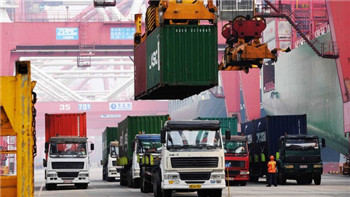
China will release gross domestic product figures for the fourth quarter of 2015 on Tuesday amid rising concern about the health of the country’s economy — which in turn has reverberated through global markets.
中国将在周二发布2015年第四季度的国内生产总值(GDP)数字,当前各方越来越担心中国经济的健康状况,这进而在全球市场引发冲击波。
China’s economy grew 6.9 per cent in real terms in the first three quarters, official data show. That is in line with the government’s full-year target of “around 7 per cent” but would be the slowest full-year growth since 1990. Here are five things to look for in Tuesday’s numbers:
官方数据显示,中国经济在2015年前三季度实际增长6.9%。这与政府“7%左右”的全年目标吻合,但将是自1990年以来最慢的全年增长。以下是周二数字中的五个看点:
Nominal growth. Suspicion surrounds China’s “GDP deflator”, the inflation gauge used to convert nominal GDP into the politically sensitive real GDP growth rate. The GDP deflator should be the broadest measures of inflation, capturing price changes for all goods and services, including non-consumption goods. But if the fourth-quarter deflator diverges sharply from more familiar gauges of Chinese inflation, investors will suspect that China’s stats bureau is cooking the books and look to nominal growth as a more reliable indicator of the state of the economy.
名义增长。围绕中国的“GDP平减指数”(对名义GDP进行通胀调整,得出政治上敏感的实际GDP增长率),人们抱有种种疑虑。GDP平减指数应该是最广义的通胀指标,涵盖所有商品和服务(包括非消费品)的价格变化。但是,如果第四季度的平减指数大幅偏离人们比较熟悉的中国通胀指标,投资者将怀疑中国国家统计局在数据上做手脚,因而把名义增长率视为反映经济状况的更可靠指标。
‘Other’ services. As traditional growth engines such as manufacturing and construction wane, services are now the main drivers of China’s growth. In the third quarter, a broad category called “other” services — which includes healthcare, education, law, and accounting among others — boosted China’s unexpectedly strong headline growth figure.
“其他”服务。随着制造业和建筑业等传统增长引擎失去动力,服务业目前是中国经济增长的主要驱动因素。2015年第三季度,被称为“其他”服务的一个大类(包括医疗、教育、法律、会计等等)提振了中国强劲得出人意料的整体增长数据。
Yet many are sceptical about these figures due to the lack of specifics, the inherent challenges of measuring the value of services, and suspicions that China’s statisticians fudge the data to meet predetermined targets. If the government provides more detail about which services are growing fastest, it could allay the scepticism. If not, doubts will grow.
然而,许多人怀疑这些数字,理由是缺乏具体细节、衡量服务价值的固有挑战,以及对于中国统计人员捏造数据以达到预定目标的疑心。如果政府提供关于哪些服务增长最快的更多细节,它可能化解疑虑。不然的话,外界的疑心将会加重。
Financial services. In addition to “other” services, financial services were a major contributor to overall growth through the first three quarters as China’s stock market boom early in the year drove trading commissions and other brokerage services. In the fourth quarter, base effects will start to kick in, however, as the stock market boom began around November 2014.
金融服务。除了“其他”服务外,金融服务在2015年前三个季度对中国的总体增长做出重大贡献,因为去年上半年的国内股票牛市推动了交易佣金和其他券商服务。然而,基数效应将在第四季度显现,因为这一轮牛市是从2014年11月前后开始的。
Moreover, the trading volumes that ramped up during the first half of the year’s rally and bust were far more muted during the fourth quarter recovery. Another strong growth contribution from financial services will fuel more data scepticism.
此外,2015年上半年股市大涨大跌期间急剧扩大的交易量,到了第四季度的回升期间下降了很多。如果数据显示金融服务再次对增长做出强劲贡献,那将加剧人们对中国经济数据的怀疑。
Industrial production. The statistics bureau will release monthly industrial output data alongside the quarterly GDP figures on Tuesday. Factory surveys for December indicated that China’s struggling manufacturing sector may have finally bottomed out after declining for most of 2015. Industrial production accelerated strongly in November after hitting a near seven-year low in October. If the acceleration continued in December, it may be a sign that the worst is over for China’s factories
工业产出。除季度GDP数据外,国家统计局还将在周二发布月度工业产出数据。12月的工厂调查显示,中国苦苦挣扎的制造业在2015年大部分时间内下滑之后,可能已终于触底。工业产出在10月降至近七年低点后,在11月强劲提速。如果12月继续加速,那可能是一个表明中国的工厂已挺过最糟糕时期的迹象。
Net exports. The contribution to annual GDP growth from net exports was zero or negative from 2008 to 2014, undermining the conventional wisdom about China’s “export-led” economy. But China’s merchandise trade surplus surged to a record of $595bn in 2015 as tumbling commodity prices lowered the country’s import bill, customs data show. Customs figures do not include services trade, however, so the GDP figures will reveal how much net exports cushioned the slowdown in the domestic economy.
净出口。2008至2014年期间,净出口对全年GDP增长的贡献为零或负值,突显有关中国“出口导向型”经济的传统看法并不准确。但海关数据显示,2015年期间,随着大宗商品价格暴跌降低了中国的进口账单,中国的商品贸易顺差飙升至5950亿美元的创纪录高位。不过,海关数据并不包括服务贸易,因此GDP数字将揭示净出口在多大程度上缓冲了国内经济放缓。












